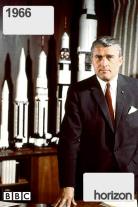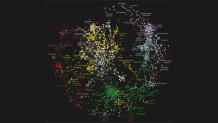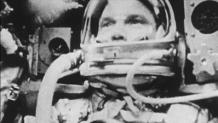
Horizon (1964)
Horizon tells amazing science stories, unravels mysteries and reveals worlds you've never seen before.
User rating:
1966x01 Windows of the Soul
02 January, 1966 9:00 pm
Horizon follows experiments on the eyes being undertaken at the Department of Psychology at the University of Chicago. The purpose of the experiments are to discover if our eyes can tell us things we might prefer to keep secret.
Also: Elixir of Youth - In Rumania, more than forty thousand people have been given gerovital H3, in the belief that it will make them younger, by Dr. Ana Aslan Dr. Alex Comfort comments on a film about this mass experiment
1966x02 The Troubled Mind
16 January, 1966 9:00 pm
Horizon explores an American mental hospital, observing schizophrenic patients under treatment with remarkable new drugs.
1966x03 A Man of Two Visions
30 January, 1966 9:00 pm
A profile of Dr. Albert Copley, the famous hematologist, who is also known as an accomplished artist under the name of Alcopley.
1966x04 A Theory of the Earth
13 February, 1966 9:00 pm
The eminent Canadian geologist. Professor Tuzo Wilson , explains his new ' Froth on the Broth ' theory of the structure of the earth to David Wilson before his recent lecture to the Royal Geological Society
1966x05 Route 128
27 February, 1966 9:00 pm
North of Boston, on Route 128, a new industrial landscape based on science is developing. Here men of high intellectual qualifications are developing way-out products, including a helicopter powered by radio waves, a computer which teaches medical diagnosis, and a hair-raising way of testing driving conditions. with Dr. Dennis Robinson
1966x06 The Beginning of Life
13 March, 1966 9:00 pm
Horizon looks at the life cycle during the development of a human embryo.
1966x07 So You Want to be an Inventor?
27 March, 1966 9:00 pm
Horizon looks into inventors who struggle against exploding technology, the buying power of great industries and taxation problems to make their leaps into the unknown.
1966x08 Chance and Decay
10 April, 1966 9:00 pm
Europe's heritage of pictures, statues. and buildings is being destroyed at a frightening rate by atmospheric pollution, but an American scientist has just invented a method of preserving limestone which conservationists hope will change the situation radically.
Also: Meteorite Mystery - In 1908 a vast explosion shook the Tungus district of Siberia: was it due to the biggest meteorite ever to hit the earth, or something odder? The Russians, after sending out many expeditions, have just released a filmed report.
1966x09 Towers of Ilium
24 April, 1966 9:00 pm
The location of the historic city of Troy was finally pinned down by the researches of CARL BLEGEN , the detailed results of whose work have only recently become available.
Also: The Exploding City - By A.D. 2,000 more than half the world's population may be living in cities. The population of some of them may exceeed 60 million. This is one of the main preoccupations of the World Institute of Ekistics, founded in London this month with Lord Llewelyn-Davies
Architect, and Chairman of the Centre for Environmental Studies Constantinos Doxiadis.
1966x10 Man in Space
08 May, 1966 9:00 pm
Horizon travels to the spacecraft center in Houston, Texas to study astronauts in space and how they react to being in space and the stresses of launching and re-entry.
1966x11 Destination Mars
22 May, 1966 9:00 pm
Detailed plans for an eighteen-month expedition in which a fleet of gigantic nuclear-powered spacecraft will land men on Mars are disclosed by Dr. Ernst Stuhlinger of N.A.S.A., who demonstrates a model of the spacecraft which it is planned to use.
Also: Editors in Conference - The Editors of two leading scientific magazines, Dennis Flanagan of the Scientific American, and Nigel Calder of the New Scientist, discuss with Gordon Rattray Taylor the problems of popularising science and placing it in a social context.
1966x12 Man Meets Duck
05 June, 1966 9:00 pm
At his Institute in Bavaria, Konrad Lorenz , the world-famous author of King Solomon's Ring and Man meets Dog, lives surrounded by his flocks of ducks and geese. He is studying these creatures in the hope of throwing light on man's behaviour. Tonight's visit to this unique establishment shows the results of some of Dr. Lorenz's exciting experiments in this field.
Also: The Picture Machines - The world knows all about the uncanny mathematical abilities of the computer. But what happens when these machines learn to draw?
1966x13 Where Must the Money Go?
19 June, 1966 9:00 pm
Today many sophisticated pieces of medical hardware are coming out of the laboratory and into the hospital, among them kidney machines, artificial hearts, and monitoring devices for coronary victims. But these machines are often very expensive and may tie up capital in the treatment of chronic illness, capital which could be used for other, perhaps equally urgent, cases. How does international medical opinion see the outcome of this dilemma?
Also: Phantoms Incorporated - Radiation studies, manned spaceflight experiments, and accident research all depend, for many of their results, on ' Phantoms.' These are substitutes for humans that give valuable information on the limits of tolerance of the human body. Horizon looks at their manufacture and functions.
1966x14 Genes in Action
03 July, 1966 9:00 pm
An eighteen-foot-high model of a ' chromosome puff ' has just been unveiled in Chicago. Some chromosomes ' puff' when they undergo intense genetic activity, and this model is based on the latest research into the microscopic world of the gene. The model was filmed under construction and after completion, and Professor John Maynard Smith of the University of Sussex and Dr. John Curdon of the University of Oxford discuss the implications of the sort of genetic research which the model exemplifies.
Also: Scientists and War - Sir Solly Zuckerman talks about his new book Scientists and War which outlines his views on the impact of science on affairs civil and military.
1966x15 The Lonely Children
17 July, 1966 9:00 pm
They're called aloof, self-absorbed. They don'meet your eyes, won'be cuddled, can'play with other children. They are autistic children. This programme looks at this heart-rending condition and examines the way in which medicine is studying these children.
1966x16 Man of Science
31 July, 1966 9:00 pm
H. G. Wells is best known as a writer of science romances and a man who, with remarkable accuracy, predicted future technological developments from the tank to space-shots. Behind the writer lay the shadow of the scientist he nearly became. Tonight's programme looks at the other side of this complex figure.
Also: 'Nature' Tomorrow - An interview with John Maddox , the new editor of one of the world's most influential scientific journals, Nature, in which he discusses his ideas for bringing up-to-date the magazine's coverage of scientific events.
1966x17 The Dolphins that Joined the Navy
11 September, 1966 9:00 pm
American Navy scientists are engaged in an intensive programme of research on the most intelligent and friendly of sea creatures, the dolphin. and in particular on its almost uncanny powers of navigation.
1966x18 M.I.T's ABC
25 September, 1966 9:00 pm
One of the U.S.A.'s Meccas for scientists and engineers, the Massachusetts Institute of Technology, has started up courses in art because some of its professors feel ' most students don't know their ABCs in visual terms.' Do British science students know their ABCs?
Also: The Disturbed Child - Many parents know that their child has a problem but do not have the necessary insight to deal with it: the problem might be as apparently simple as bed-wetting or stammering. A woman psychiatrist uses drawings and paintings to reveal children's characters and show the results of therapy.
1966x19 Ten Years in the Antarctic
10 October, 1966 9:00 pm
Horizon looks at the scientific research being carried out in the Antarctic under the guidance the Scientific Committee for Antarctic Research (SCAR) which was formed in 1856.
1966x20 The Athlete
24 October, 1966 9:00 pm
Is there any limit to Improvements In human athletic performance? If so, what?
Roger Bannister the first four-minute miler discusses his performances In tonight's programme with physiologists and psychiatrists who make their predictions
1966x21 From Peenemünde to the Moon
07 November, 1966 9:00 pm
If U.S. hopes are fulfilled the tremendous power of the Saturn IB rocket motor should, within a few weeks, lift a three-man spacecraft to orbit the earth.
Wernher von Braun, the German V2 rocket engineer who played a critical part in the development of U.S. rocketry, appears in a report on 700 years of rocket science and its attempt to realise a space travel dream.
1966x22 Sex-Change?
21 November, 1966 9:00 pm
Sex-change frequently makes press headlines along with confusing reports of the physiology involved. The withdrawal of five gold-medal-winning women athletes from this year's European Championships, supposedly to avoid the recently introduced ' sex checks,' has raised the question again.
What does ' sex-change ' mean?
Does it, in fact, happen? In one of tonight's items Horizon looks at this complex psychological and physiological subject.
1966x23 The Structure of Life
05 December, 1966 9:00 pm
For their work on penicillin, the drug which saved so many lives in World War II, three men were awarded the Nobel Prize. Tonight's film looks at one of these men, Professor Ernst Chain.
It also looks at the remarkable growth during this century of biochemistry and at some of the unusual research in progress in Professor Chain's new £1,500,000 Biochemistry Department at Imperial College.
1966x24 Hand Me My Sword, Humphrey
25 December, 1966 9:00 pm
It is Christmas Day in the house of Hastings. The time (the 1830s), the place (a suburban Victorian home). and the atmosphere (after the pudding with the children waiting to be entertained) are ripe for father to stun his audience with his knowledge of the world of natural philosophy. It is a world of exploding biscuit tins, unpredictable hard-boiled eggs, singing drainpipes, and enough amateur science to make young enthusiasts reach for their bunsen burners, and mothers for their smelling salts
Video Gallery
Coming Soon...
Photo Gallery
Coming Soon...


